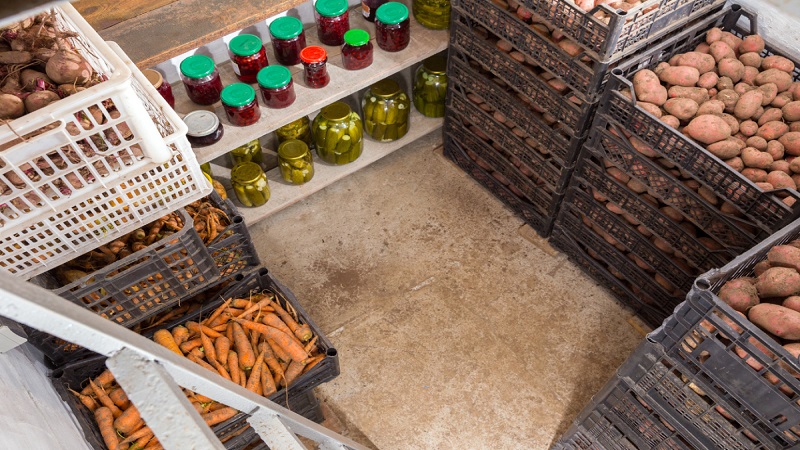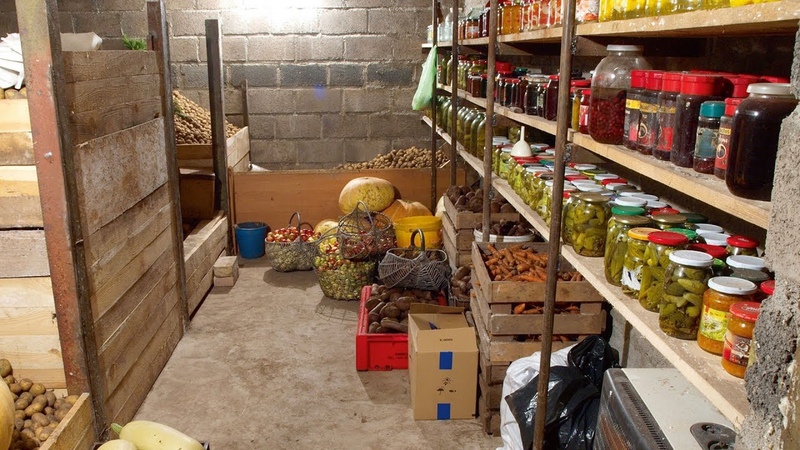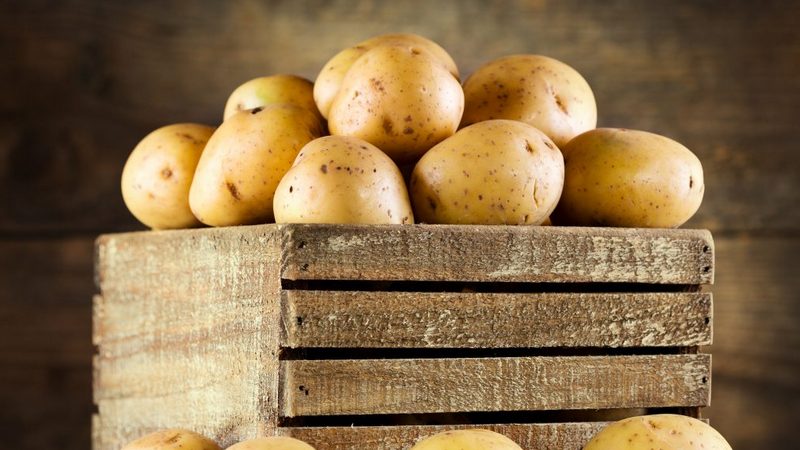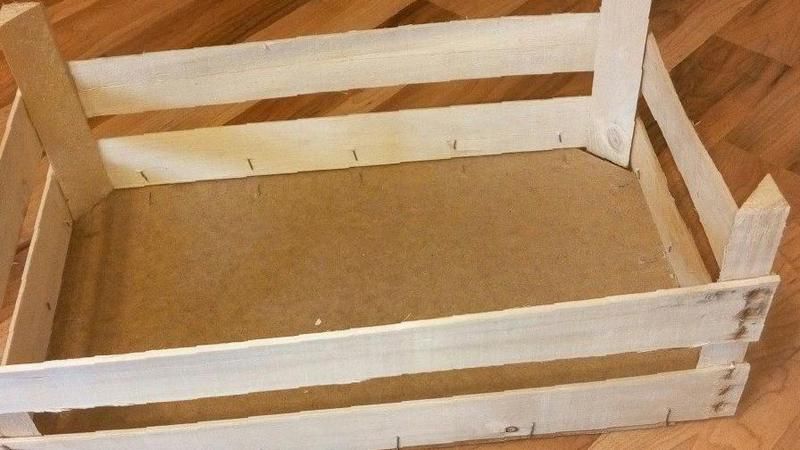How to make a box for storing potatoes with your own hands
Sometimes it is easier to grow a potato than it is to create conditions for its winter storage. This problem is especially urgent for the townspeople. You can buy a device for storing potatoes in an apartment, or you can do it yourself.
How to make such boxes, and what conditions should generally be for long-term preservation of potatoes in the cellar, in the basement and in the house - we will tell in the article.
The content of the article
Storage conditions for potatoes and preparation for it

Preparation of potatoes for storage begins from the moment of harvest. After the cleaning process, you must:
- Dry the potatoes. Leave the tubers in place for 1-2 hours.
- Transfer to a shaded area and leave for 4-5 hours. During this period, the peel will coarsen, which increases the protective properties of the tubers.
- Thoroughly clean off the ground and sort by size.
Storage conditions for potatoes:
- The room temperature must be between + 2 ° C and + 4 ° C. At this temperature, all biochemical processes slow down, which allows the potatoes not to germinate and freeze for a long time. If the temperature is not observed, the tubers will either sweeten (at low temperatures), or a crust that is too thick (at high temperatures) will form.
- The place where the potatoes will liemust be protected from sunlight and prolonged artificial lighting.
- To prevent fungal and bacterial infections, the storage area of vegetables is treated with special preparations.
- Isolation from rodents and other pests must be present.
- Indoor humidity - no higher than 80%. High humidity provokes diseases and activates tuber germination.
Where and how you can store potatoes at home
Everyone chooses where and how to store potatoes, based on their capabilities.
In the cellar

Cellar storage is by far the best way. The conditions created in such a room are optimal for potatoes. There is no natural light or high temperatures in the cellar.
Before folding the potatoes, check that all conditions are met. If necessary, the room is insulated and treated from rodents, after which the container is transferred to the storage location.
Important! It is not recommended to store potatoes in bags - they begin to rot and sprout.
If all the conditions for keeping in the cellar are met, the tubers will remain in good condition for up to ten months.
In the basement
In the basement, potatoes are stored:
- by the bulk method;
- in boxes;
- on shelves.
When using the bulk method, the height of the embankment should not exceed one meter. Do not sprinkle potatoes on a bare floor. Bins are often built in basements - large wooden boxes. They necessarily provide for gaps between the crossbeams for ventilation.
Many summer residents practice storing potatoes on racks. Tubers are laid out on a shelf in one layer. So it is easier to follow them and discard the spoiled ones.
On the balcony
To store potatoes on the balcony, use:
- wooden boxes;
- thermal container;
- old refrigerator.
Important! The storage area must be insulated to reduce the risk of tubers freezing at low temperatures. For this, the walls of the bottom and lid of the box are insulated with sawdust, wood shavings or foam.
At the onset of subzero temperatures, the container is wrapped using old clothes or a blanket, old fur coats or canvas bags.
Important! Sunlight must not penetrate inside the container. It provokes the release of solanine.
To regulate humidity, put in the box:
- onion peel;
- beets;
- a sprig of elderberry;
- bag of mint.
Under these conditions, the temperature in the container will be up to + 7 ° C.

In the corridor
Storing potatoes in the hallway is not the best solution, but sometimes the only possible one. In such conditions, it is difficult to achieve the desired temperature and humidity. Typically, the corridor is used as temporary storage. The container should be ventilated, a bottle or can of water is placed next to it to raise the humidity. Sometimes the box is displayed in the vestibule or entrance. In this case, the container is equipped with a lock from uninvited guests.
When storing potatoes in the corridor, there are sharp temperature changes from drafts, which negatively affects the condition of vegetables.
What should be a box for storing potatoes, how to make it yourself

The box is the most common container for storing potatoes. Its main advantage is mobility. It is convenient to use small boxes that can hold up to 12 kg. They are easy to carry, and there is quick access to the tubers to sort through periodically. The material is plastic, wood or cardboard. The main thing is that it is convenient to monitor the safety of tubers and there is excellent air ventilation.
Construction requirements for the cellar and for the apartment
The general rules for observing the microclimate for storing potatoes are the same for both the cellar and the apartment.
The following requirements are imposed on a homemade box:
- materials must be safe;
- to maintain an optimal microclimate, ventilation holes are made;
- the box should not let in daylight.
The only difference between the designs will be its size. As a rule, large structures are prepared for the cellar - bins, but this is impossible in an apartment.
Important! For storage in small spaces, choose a design with a top cover.
What materials to make
Available and inexpensive materials for making the box are wood or plastic. Any wooden material is suitable: lining, plywood, chipboard, ordinary board. At the beginning, a frame is created, and then sheathed with a wooden beam.
The advantage of making containers with your own hands is that you will precisely adjust its dimensions to the parameters of your storage space. If you stopped at the plastic version, then today in hardware stores there are a lot of options for containers made of polymers. Among them, there will probably be a suitable size.

Training
First, determine the place where the box will stand:
- the box should not stand on the aisle and interfere with movement;
- the box is not installed where strong drafts can occur, it will pull cold and the tubers will freeze.
Next, the size of the box is calculated. The parameters will depend on:
- the amount of potatoes;
- the area allocated for storage;
- construction forms;
- type of door opening.
To complete the work you will need:
- material;
- nails or screws;
- corners;
- thermal insulation;
- instruments.
It is not necessary to buy new materials - the boards remaining after the repair will do.
Design features

All boxes for storing potatoes have a common structure:
- to ensure full ventilation, the walls are made with holes;
- legs are attached to the bottom for better ventilation;
- all internal surfaces are made of wood to avoid the absorption of toxic substances by tubers;
- all surfaces are made smooth so as not to damage the tubers;
- be sure to make a cover - for darkening.
Step by step manufacturing
After determining the location and dimensions, a drawing is made in which all the details are displayed. Then they start manufacturing.
Important! It is more convenient to make the front wall collapsible for direct access to the potatoes lying at the bottom of the box.
Manufacturing steps:
- Bars for the frame are prepared and sawn.
- The frame is assembled using metal corners. The corners allow you to achieve perfectly even corners and add additional rigidity to the structure.
- The back wall of the frame is sheathed with boards, leaving 1 cm gaps between them.
- Turn the product over and sheathe the front wall to half the height from the bottom, observing the distance between the boards. The upper part of the wall will be collapsible. To do this, make guides from aluminum corners. The corners are screwed to the vertical bars in such a way that there is a distance between the corner and the bar a little more than the thickness of the board.
- Finish the lining of the remaining walls and bottom of the box, not forgetting the distance between the boards.
- Make legs. To do this, screw three smaller bars to the bottom.
- Insert removable boards at the front of the drawer. Since they do not have to be fixed, the distance between them is controlled with screws, screwing them into the side walls of the board.
- Make a lid. For this, a frame is assembled, its corners are fixed with corners.
- Fasten the frame to the drawer with a long furniture hinge.
- Sheathed the lid with boards.
This box is perfect for storing potatoes in a basement or hallway.
If a balcony is chosen as a storage place, the box is made insulated:
- Two boxes are built in such a way that one fits into the other and there is a space between the walls of at least 5 cm.
- Any heat-insulating material is placed in this space.
- The lid is also made double and insulated.
At subzero temperatures in winter, a heating is inserted into the box. You will need a piece of perforated pipe. It is vertically fixed in the center of the container, and a light bulb with a cartridge or a hairdryer is inserted inside.
Important! The boards must be smooth, without any roughness, otherwise, when laying for storage, the tubers will be damaged and begin to rot.
How to handle boxes
Storage boxes are pre-treated with the following disinfectant solutions:
- copper sulfate;
- bleach;
- strong solution of potassium permanganate;
- after being dried on the street.
Important! If the loggia or balcony is not glazed, additionally paint the outer surfaces of the box with waterproof paint.

Storage rules
General requirements for long-term storage of potatoes:
- dark room without access to natural light;
- good ventilation;
- temperature from + 2 ° С to + 7 ° С;
- humidity up to 80%;
- the potatoes are dried and sorted.
It is advisable to process the storage room or container before storage.
Important! For long-term storage, use potatoes only late varieties. Early varieties stored for no more than several months.

If the storage rules are not followed, there is a risk:
- infection of potatoes with fungal diseases;
- the tubers turn green;
- potato growth is activated;
- low temperatures produce a sweetish taste, and high temperatures form a crust.
If all storage rules are followed, the tubers will remain suitable for eating for as long as possible, retain their taste and nutritional value.
Read also:
Conclusion
To preserve potatoes, it is worth considering the most common mistakes, which significantly reduce the timing and amount of the harvest. When stored in a special box, potatoes can remain fresh, tasty and healthy for 6-8 months. Each person with minimal carpentry skills and a set of tools can independently make such a container.